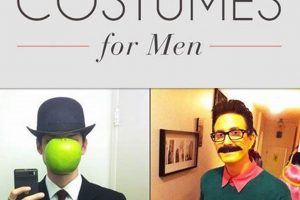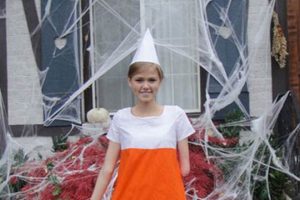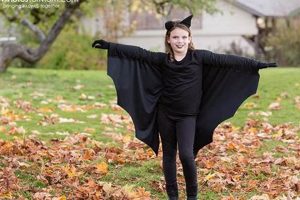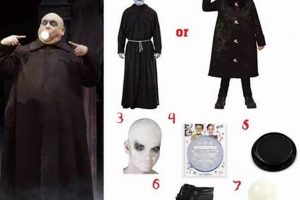The creation of a homemade Amelia Earhart outfit involves crafting a recognizable and historically inspired ensemble using readily available materials. Examples include repurposing existing clothing items like brown jackets and trousers, and supplementing them with DIY accessories such as a pilot’s cap fashioned from felt or fabric scraps, and goggles constructed from craft materials.
The significance of constructing such a costume lies in its capacity to provide an engaging and educational experience. It allows individuals to connect with history in a tangible way, fostering an appreciation for Amelia Earhart’s accomplishments and her impact on aviation. The project also encourages creativity and resourcefulness by requiring participants to adapt and modify materials to achieve the desired aesthetic, thus promoting skills in crafting and problem-solving.
The following sections will elaborate on specific aspects of creating such a costume, including sourcing appropriate materials, crafting key accessories, and assembling the final look to capture the essence of the renowned aviator.
Tips for Constructing an Amelia Earhart Costume
The successful creation of a historically accurate and recognizable aviator costume necessitates careful attention to detail and a resourceful approach to material selection and construction.
Tip 1: Material Sourcing: Prioritize durable and appropriate fabric choices. Brown leather or faux leather jackets, paired with khaki or corduroy trousers, provide a foundation for the outfit. Scour thrift stores and online marketplaces for cost-effective options.
Tip 2: Aviator Cap Fabrication: A signature element is the aviator cap. Consider utilizing felt or sturdy cotton fabric to construct the cap, paying close attention to period-accurate patterns. Secure ear flaps with snaps or buckles for added authenticity.
Tip 3: Goggle Construction: Replicate the iconic goggles using readily available craft supplies. Plastic lenses from discarded toys or safety glasses can be integrated into a frame fashioned from cardboard or craft foam, then painted or wrapped with leather-like material.
Tip 4: Scarf Selection: A long, flowing scarf adds a touch of elegance and practicality. Opt for a neutral color, such as cream or white, in a lightweight fabric like silk or cotton. Draping the scarf around the neck provides a visual representation of the aviator’s attire.
Tip 5: Accessory Enhancement: Consider incorporating additional accessories to enhance the overall impression. A map case, a pair of work gloves, or a vintage-style wristwatch contribute to a more complete and believable depiction.
Tip 6: Attention to Detail: Research historical photographs and descriptions of Earhart’s attire. Paying attention to details, such as the placement of buckles and straps, or the specific style of her flight jacket, enhances the authenticity of the costume.
Tip 7: Comfort and Functionality: While accuracy is important, prioritize comfort and functionality. Ensure the costume allows for ease of movement and does not impede visibility. Adjustments may be necessary to achieve a balance between historical accuracy and practical wearability.
Adhering to these guidelines will facilitate the construction of a compelling and respectful portrayal of the pioneering aviator. The result will be a wearable tribute to her legacy, crafted with resourcefulness and attention to detail.
The subsequent sections will provide specific instructions for creating individual components, allowing for a step-by-step approach to costume construction.
1. Jacket
A brown, leather-like jacket serves as a foundational element in constructing a recognizable and historically plausible aviator costume. This selection stems from the prevalence of leather and leather-adjacent materials in early 20th-century flight gear, offering protection against the elements in open-cockpit aircraft. The jacket’s visual association with Amelia Earhart is largely due to photographic records and portrayals depicting her wearing similar apparel. Therefore, the jacket functions as a critical signifier, immediately conveying the intended character. Absent this component, a costume aiming to represent Earhart loses a substantial degree of its recognizability and historical grounding.
The specific style of jacket can vary, ranging from a classic bomber jacket to a more fitted style. However, the material and color remain key factors. The material should convincingly mimic leather, whether it is genuine leather, faux leather, or a durable fabric with a similar texture. The color should consistently be in the spectrum of brown, ranging from dark browns to lighter tans, to align with known photographic evidence. Sourcing options might include thrift stores, online marketplaces, or costume shops. Modifications, such as adding patches or adjusting the fit, can further enhance the jacket’s authenticity. The choice of stitching can also add realistic touch to the DIY project.
In conclusion, the brown, leather-like jacket plays a pivotal role in achieving a successful and believable representation of Amelia Earhart. Its significance arises from its historical context, visual prominence, and its contribution to the overall impact of the homemade costume. Recognizing its importance is crucial for those seeking to create an accurate and respectful portrayal of the iconic aviator. The main challenge lies in obtaining a jacket that balances historical accuracy with affordability and comfort, ultimately achieving a balance between aesthetics and practicality.
2. Trousers
Khaki or corduroy trousers function as a complementary component within a homemade Amelia Earhart costume. Their presence is dictated by the historical context of aviation attire during the early to mid-20th century, specifically the practical and stylistic choices prevalent among pilots and adventurers. The selection of these trouser types for an Amelia Earhart costume stems from photographic evidence and historical documentation depicting her wearing similar garments. They are important because they add a layer of historical accuracy to the costume. They also contribute to an aesthetic alignment with the time period. The use of either khaki or corduroy provides flexibility. This is particularly valuable when assembling the costume using repurposed or readily available materials. An example is a photograph of Earhart wearing riding breeches. It is evident that the lower half of the costume requires a style of durable, neutral-toned trousers. The material and color of the trousers serve to ground the overall impression, complementing the more prominent features such as the jacket and aviator cap.
The substitution of other trouser types, such as denim or modern synthetics, reduces the costumes adherence to the historical period. While denim trousers existed during Earharts lifetime, they were not co
mmonly associated with aviation attire. Similarly, contemporary synthetic materials lack the visual texture and historical authenticity of khaki or corduroy. Consider a scenario where a brown bomber jacket and aviator cap are paired with modern jeans; the resulting ensemble lacks the cohesiveness and historical resonance achieved through the inclusion of appropriate trousers. The material choice also influences the comfort and practicality of the costume. Corduroy trousers, for example, offer increased warmth, while khaki provides breathability, a consideration for extended wear.
In summary, the inclusion of khaki or corduroy trousers within an Amelia Earhart costume serves as a crucial element in achieving historical accuracy and aesthetic coherence. These trousers’ color and material are vital. They link the costume to the broader context of early aviation. Furthermore, the selection of suitable trousers reinforces the authenticity of the overall portrayal. The primary challenge lies in sourcing materials that effectively balance historical accuracy with modern comfort and availability, a balance that is essential for a successful recreation.
3. Aviator Cap
The aviator cap is an indispensable component of any attempt at an Amelia Earhart costume. Its visual prominence and historical significance render its inclusion non-negotiable for achieving a recognizable and respectful portrayal.
- Visual Recognition
The aviator cap is a readily identifiable element associated with Amelia Earhart. Its presence immediately signals the intended character to observers. Historical photographs and popular representations consistently depict Earhart wearing a similar cap. The absence of this item compromises the overall visual impact of the costume, diminishing its ability to be easily recognized.
- Historical Accuracy
Aviator caps were functional necessities during the early era of aviation. They provided protection from wind and cold in open-cockpit aircraft. Earhart, as a pioneering aviator, would have regularly worn such headwear during her flights. The inclusion of an aviator cap, therefore, provides the costume with a degree of historical authenticity that goes beyond mere aesthetic considerations. It connects the costume to the real-world practices of aviation in Earhart’s time.
- Construction and Materials
The construction of the cap influences its overall effectiveness. Materials like leather, faux leather, or durable cotton are appropriate choices. The design should incorporate ear flaps, which could be secured with straps or buttons. The overall fit of the cap should be snug but comfortable, allowing the wearer to move freely without it shifting excessively. The use of historically accurate patterns enhances the costume’s authenticity.
- DIY Adaptation
The relatively simple design of an aviator cap lends itself well to do-it-yourself construction. Existing patterns can be modified, or new ones created from scratch. Recycled materials can be used creatively, aligning with the resourceful nature of homemade costumes. Embellishments like stitching or added details can further personalize the cap, enhancing its visual appeal and making it a unique element of the costume.
The aviator cap functions as more than just a head covering; it is a critical symbol within the construct of an Amelia Earhart costume. Its integration is paramount. It provides instant recognition. Also, it grounds the ensemble in historical reality. The creative adaptation of materials and construction techniques further enhances the personal connection to the historical figure. It elevates the costume beyond a simple imitation.
4. Goggles
Goggles constitute a crucial accessory in the realization of a believable and historically informed Amelia Earhart costume. Their presence directly impacts the perception of authenticity, linking the wearer visually to the historical context of early aviation.
- Visual Identification and Historical Context
Goggles are undeniably associated with early aviators, including Amelia Earhart. Open-cockpit aircraft necessitated protective eyewear. This was to shield the eyes from wind, debris, and glare. Reproducing this element accurately enhances the costume’s visual recognizability. Authentic eyewear places the costume firmly within the historical period.
- Material and Design Considerations
The material and design of the goggles contribute to their perceived authenticity. Period-appropriate goggles feature round lenses encased in metal or leather frames. The strap securing the goggles is typically made of leather or elastic. Replicating these design elements, even with cost-effective materials, improves the overall impression of the costume. Consider using craft foam or repurposed materials for the frame to minimize expenses.
- Impact on Overall Costume Cohesion
The absence of suitable goggles detracts significantly from the effectiveness of the costume. While other elements, such as the jacket and cap, contribute to the overall appearance, the goggles provide a focal point that reinforces the aviator theme. In contrast, using modern sunglasses or neglecting eyewear altogether undermines the historical accuracy and aesthetic consistency of the ensemble.
- DIY Construction Techniques
Constructing goggles is feasible using do-it-yourself methods. Recycled plastic can serve as lenses. Craft foam or cardboard can be used to fashion the frame. These materials can be covered with fabric or paint to mimic leather or metal. An elastic strap completes the construction, allowing for adjustable and comfortable wear. These techniques allow the user to custom the style of their goggles to fit their costume.
Integrating authentic-looking eyewear into an Amelia Earhart costume project transcends mere accessorizing; it serves to anchor the portrayal in the historical reality of early aviation. Attentiveness to the details of material, design, and construction directly enhances the costume’s overall impact and believability. Sourcing the right supplies is a cornerstone to a realistic and satisfying recreation.
5. Scarf
A flowing, neutral-colored scarf holds significant importance within the realm of an “amelia earhart costume diy” project. Its inclusion is not merely decorative; it serves as a visual cue, readily associated with the aviators iconic style and the historical context of early flight. The scarf provided practical utility to pilots of open-cockpit aircraft, protecting against wind and drafts. Its adoption as a stylistic element, therefore, carries a tangible link to the realities of aviation during Earhart’s era. Its absence diminishes the overall authenticity of the costume, reducing its ability to effectively convey the intended historical persona. Examples from photographs and film portrayals of Earhart consistently depict her wearing a scarf, solidifying its role as a defining characteristic. The scarf acts a direct link to the past.
The practical application of this understanding involves careful material selection and styling. A lightweight fabric, such as
silk or linen, is preferable for achieving the desired flowing effect. Neutral colors, including cream, white, or light beige, align with the prevalent color palettes of the period. The scarf should be draped loosely around the neck, allowing it to billow in a manner reminiscent of flight. Furthermore, the length of the scarf should be sufficient to create a visual impact without hindering movement or posing a safety hazard. In instances where complete historical accuracy is prioritized, research into the specific types of scarves worn by female aviators during the 1930s may inform the selection process. In essence, paying attention to details, such as the material, colour and style, reinforces the costumes historical accuracy.
In conclusion, the flowing, neutral scarf is a critical element within the “amelia earhart costume diy” framework, offering both stylistic and historical significance. Its practical purpose as a protective garment during the early days of flight and its consistent visual association with Earharts image solidifies its importance. Challenges in sourcing appropriate materials and replicating the correct styling can be addressed through careful research and resourcefulness. The scarf provides and essential visual cue, helping to quickly identify the costume with the aviator. Its role extends beyond mere aesthetics, serving as a tangible link to the broader history of aviation and Earhart’s contribution to it.
6. Accessories
The inclusion of accessories, specifically a map and gloves, within the framework of an “amelia earhart costume diy” project is predicated on the principles of historical accuracy and character representation. A map symbolizes navigation and exploration, elements central to Earhart’s identity as a pioneering aviator. Gloves, typically constructed of leather or a durable fabric, represent the practical gear required for flight during the early 20th century, protecting the hands from the elements and providing a better grip on the controls. Omitting these accessories diminishes the comprehensiveness of the costume, resulting in a less convincing portrayal.
Consider the effect of their inclusion: a rolled-up map, whether antique or a convincing replica, positioned in a side pocket or held deliberately, communicates a sense of purpose and adventure. Leather or fabric gloves, worn partially or fully, suggest preparedness and a hands-on approach. Conversely, the absence of these items leaves a void in the overall narrative conveyed by the costume. A modern equivalent is a pilot in full uniform without a flight bag; the absence disrupts the intended message. Examples from commercially available aviator costumes invariably incorporate these elements, underscoring their perceived importance in accurately representing the character. A challenge in this area involves sourcing suitable maps that are both historically accurate and readily available. Antique maps can be expensive and delicate. Suitable alternative would be to reproduce the map through digital image generation, keeping in line with the themes and context.
In summary, the deliberate integration of a map and gloves, within an “amelia earhart costume diy” project, enhances the historical authenticity and narrative strength of the resulting ensemble. These accessories serve as visual cues, signaling the character’s profession, interests, and connection to the era of early aviation. A concerted effort to source or create appropriate accessories elevates the costume beyond a mere imitation. They provide a tangible link to Earhart’s accomplishments and the spirit of exploration she embodied.
7. Details
The incorporation of seemingly minor details, specifically buckles and straps, significantly influences the overall success of an “amelia earhart costume diy” project. These elements, often overlooked, contribute substantially to the historical accuracy and visual impact of the ensemble.
- Authenticity of Aviator Gear
Buckles and straps were integral components of flight gear during the era in which Amelia Earhart operated. They secured clothing, adjusted equipment, and ensured a snug fit in the often-turbulent environment of early aircraft. Replicating these elements accurately contributes directly to the perceived authenticity of the costume. For example, the aviator cap typically featured straps that secured the ear flaps, while flight jackets utilized buckles for closure and adjustment.
- Impact on Visual Cohesion
The presence of buckles and straps adds visual texture and complexity to the costume. They break up large expanses of fabric and provide focal points that draw the eye. Consider the visual difference between a plain leather jacket and one adorned with buckles at the collar and waist; the latter conveys a more detailed and historically accurate impression. The placement, size, and material of these details further contribute to this effect.
- Material Selection and Construction
The effectiveness of buckles and straps hinges on the choice of appropriate materials and construction techniques. Buckles should be made of metal or a convincing substitute, such as painted plastic, to maintain a sense of durability and authenticity. Straps should be crafted from leather, faux leather, or sturdy fabric that can withstand the tension of being tightened and loosened. Proper stitching and reinforcement are essential to prevent these details from detaching or appearing flimsy.
- Do-It-Yourself Adaptations and Resourcefulness
The creation of buckles and straps does not necessarily require specialized equipment or expensive materials. Existing buckles can be repurposed from old belts or clothing items. Straps can be fashioned from fabric scraps or repurposed leather. Creative solutions, such as using painted cardboard or craft foam to mimic buckles, can be effective in achieving the desired visual effect while minimizing costs. The key is to prioritize visual accuracy and durability.
The meticulous attention to details, such as buckles and straps, serves to elevate an “amelia earhart costume diy” project from a simple imitation to a respectful and historically informed representation. Their contribution extends beyond mere aesthetics. These small features connect the costume to the broader context of early aviation. The effort involved in replicating such details communicates a commitment to accuracy and a deeper appreciation for the historical figure being portrayed.
Frequently Asked Questions
This section addresses common inquiries and concerns regarding the creation of a historically plausible and visually compelling Amelia Earhart costume using do-it-yourself methods. The following questions and answers provide guidance on key aspects of the costume construction process.
Question 1: What constitutes the essential components of an Amelia Earhart costume?
The fundamental elements include a brown leather or faux leather jacket, khaki or corduroy trousers, an aviator cap, goggles, and a flowing, neutral-colored scarf. These items, either sourced or crafted, form the basis of a recognizable representation.
Question 2: How can historical accuracy be ensured in a do-it-yourself Amelia Earhart costume?
Historical accuracy can be achieved through meticulous research of photographs and descriptions of Amelia Earhart’s attire. Paying attention to details such
as the style of the jacket, the cut of the trousers, and the design of the aviator cap contributes to a more authentic portrayal.
Question 3: What are cost-effective alternatives for sourcing costume materials?
Thrift stores, online marketplaces, and repurposing existing clothing items offer cost-effective options for acquiring materials. Craft supplies, such as felt, cardboard, and repurposed plastic, can be used to create accessories like goggles and aviator caps.
Question 4: How is the aviator cap constructed for a do-it-yourself Amelia Earhart costume?
The aviator cap can be constructed from felt or durable cotton fabric using a period-accurate pattern. Ear flaps should be included and secured with snaps or buckles. The fit should be snug but comfortable.
Question 5: What are suitable materials for crafting goggles for an Amelia Earhart costume?
Plastic lenses from discarded toys or safety glasses can be integrated into frames fashioned from cardboard or craft foam. The frames can then be painted or wrapped with leather-like material. An elastic strap secures the goggles to the wearer’s head.
Question 6: How can comfort be balanced with historical accuracy in a do-it-yourself Amelia Earhart costume?
While historical accuracy is important, prioritizing comfort and functionality is also essential. Ensure that the costume allows for ease of movement and does not impede visibility. Adjustments may be necessary to achieve a balance between historical accuracy and practical wearability.
A successful “amelia earhart costume diy” project balances historical accuracy with resourcefulness and wearability. Attention to detail and creative adaptation of materials result in a compelling and respectful tribute to the pioneering aviator.
The following section provides a summary of the key steps involved in creating such a costume.
Conclusion
This article has explored the multifaceted process of creating an “amelia earhart costume diy.” Key elements such as the jacket, trousers, aviator cap, goggles, scarf, and accessories have been examined in detail, emphasizing the importance of historical accuracy, material selection, and construction techniques. Successful costume creation hinges on a balance between authenticity and practicality, achieved through resourceful adaptation and meticulous attention to detail.
The construction of such a costume offers more than a simple act of imitation; it represents an engagement with history and a tribute to a pioneering figure. Through diligent effort, the legacy of Amelia Earhart can be honored and celebrated, ensuring that her spirit of adventure continues to inspire future generations.







